emergency starting FIAT DUCATO 244 2005 3.G Owners Manual
[x] Cancel search | Manufacturer: FIAT, Model Year: 2005, Model line: DUCATO 244, Model: FIAT DUCATO 244 2005 3.GPages: 258, PDF Size: 4.05 MB
Page 9 of 258
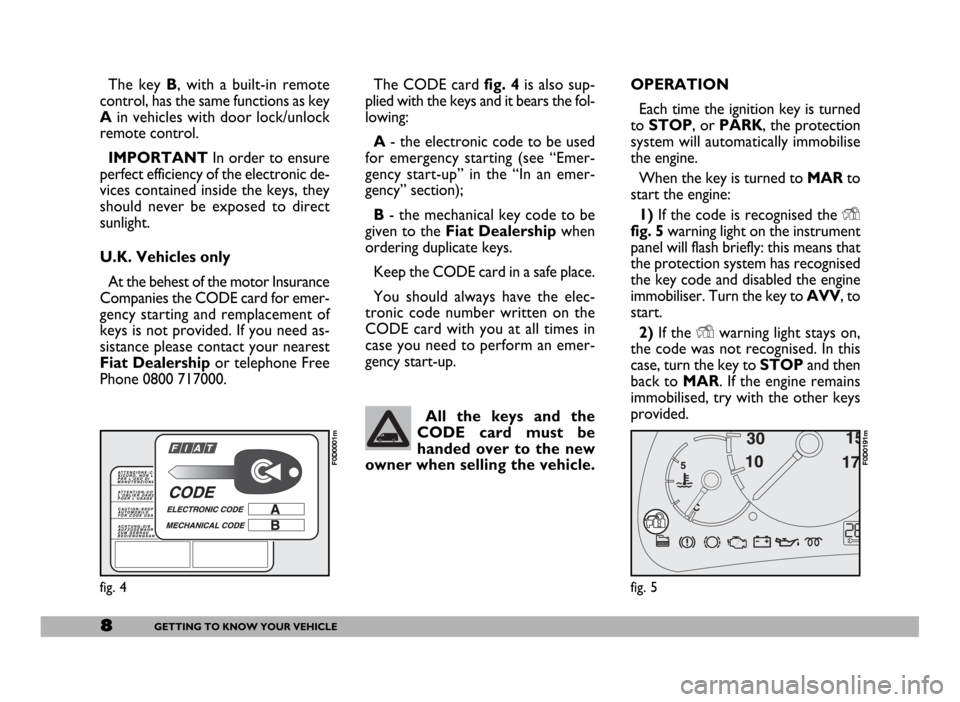
The CODE card fig. 4is also sup-
plied with the keys and it bears the fol-
lowing:
A- the electronic code to be used
for emergency starting (see “Emer-
gency start-up” in the “In an emer-
gency” section);
B- the mechanical key code to be
given to the Fiat Dealershipwhen
ordering duplicate keys.
Keep the CODE card in a safe place.
You should always have the elec-
tronic code number written on the
CODE card with you at all times in
case you need to perform an emer-
gency start-up. OPERATION
Each time the ignition key is turned
to STOP, or PARK, the protection
system will automatically immobilise
the engine.
When the key is turned to MARto
start the engine:
1)If the code is recognised the Y
fig. 5warning light on the instrument
panel will flash briefly: this means that
the protection system has recognised
the key code and disabled the engine
immobiliser. Turn the key to AVV, to
start.
2)If the Ywarning light stays on,
the code was not recognised. In this
case, turn the key to STOPand then
back to MAR. If the engine remains
immobilised, try with the other keys
provided.
fig. 5
F0D0191m
All the keys and the
CODE card must be
handed over to the new
owner when selling the vehicle.
8GETTING TO KNOW YOUR VEHICLE
The key B, with a built-in remote
control, has the same functions as key
Ain vehicles with door lock/unlock
remote control.
IMPORTANTIn order to ensure
perfect efficiency of the electronic de-
vices contained inside the keys, they
should never be exposed to direct
sunlight.
U.K. Vehicles only
At the behest of the motor Insurance
Companies the CODE card for emer-
gency starting and remplacement of
keys is not provided. If you need as-
sistance please contact your nearest
Fiat Dealershipor telephone Free
Phone 0800 717000.
fig. 4
F0D0001m
Page 108 of 258
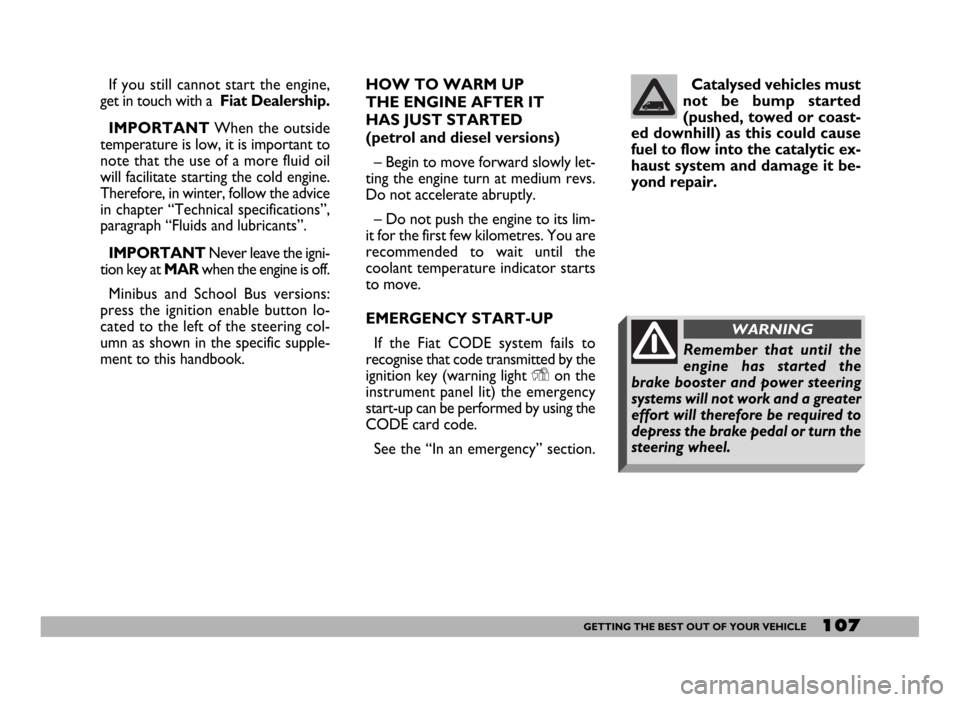
107GETTING THE BEST OUT OF YOUR VEHICLE
If you still cannot start the engine,
get in touch with a Fiat Dealership.
IMPORTANT When the outside
temperature is low, it is important to
note that the use of a more fluid oil
will facilitate starting the cold engine.
Therefore, in winter, follow the advice
in chapter “Technical specifications”,
paragraph “Fluids and lubricants”.
IMPORTANTNever leave the igni-
tion key at MARwhen the engine is off.
Minibus and School Bus versions:
press the ignition enable button lo-
cated to the left of the steering col-
umn as shown in the specific supple-
ment to this handbook.HOW TO WARM UP
THE ENGINE AFTER IT
HAS JUST STARTED
(petrol and diesel versions)
– Begin to move forward slowly let-
ting the engine turn at medium revs.
Do not accelerate abruptly.
– Do not push the engine to its lim-
it for the first few kilometres. You are
recommended to wait until the
coolant temperature indicator starts
to move.
EMERGENCY START-UP
If the Fiat CODE system fails to
recognise that code transmitted by the
ignition key (warning light Yon the
instrument panel lit) the emergency
start-up can be performed by using the
CODE card code.
See the “In an emergency” section.Catalysed vehicles must
not be bump started
(pushed, towed or coast-
ed downhill) as this could cause
fuel to flow into the catalytic ex-
haust system and damage it be-
yond repair.
Remember that until the
engine has started the
brake booster and power steering
systems will not work and a greater
effort will therefore be required to
depress the brake pedal or turn the
steering wheel.
WARNING
Page 111 of 258
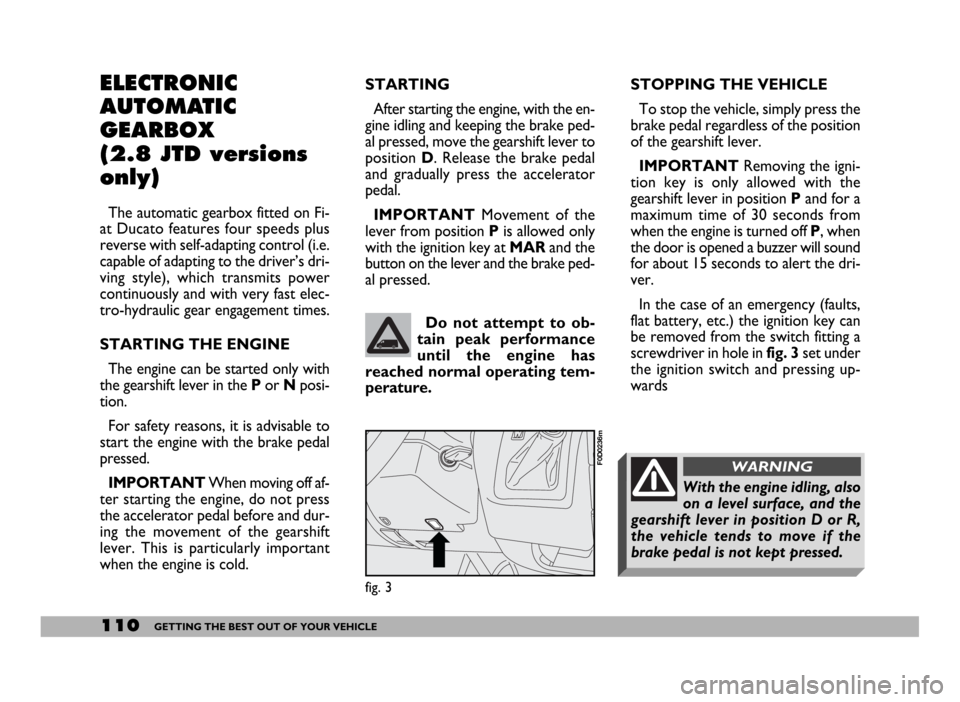
110GETTING THE BEST OUT OF YOUR VEHICLE
STARTING
After starting the engine, with the en-
gine idling and keeping the brake ped-
al pressed, move the gearshift lever to
position D. Release the brake pedal
and gradually press the accelerator
pedal.
IMPORTANT Movement of the
lever from position Pis allowed only
with the ignition key at MARand the
button on the lever and the brake ped-
al pressed. STOPPING THE VEHICLE
To stop the vehicle, simply press the
brake pedal regardless of the position
of the gearshift lever.
IMPORTANTRemoving the igni-
tion key is only allowed with the
gearshift lever in position Pand for a
maximum time of 30 seconds from
when the engine is turned off P, when
the door is opened a buzzer will sound
for about 15 seconds to alert the dri-
ver.
In the case of an emergency (faults,
flat battery, etc.) the ignition key can
be removed from the switch fitting a
screwdriver in hole infig. 3set under
the ignition switch and pressing up-
wards Do not attempt to ob-
tain peak performance
until the engine has
reached normal operating tem-
perature.
fig. 3
F0D0236m
With the engine idling, also
on a level surface, and the
gearshift lever in position D or R,
the vehicle tends to move if the
brake pedal is not kept pressed.
WARNING
ELECTRONIC
AUTOMATIC
GEARBOX
(2.8 JTD versions
only)
The automatic gearbox fitted on Fi-
at Ducato features four speeds plus
reverse with self-adapting control (i.e.
capable of adapting to the driver’s dri-
ving style), which transmits power
continuously and with very fast elec-
tro-hydraulic gear engagement times.
STARTING THE ENGINE
The engine can be started only with
the gearshift lever in the P or Nposi-
tion.
For safety reasons, it is advisable to
start the engine with the brake pedal
pressed.
IMPORTANTWhen moving off af-
ter starting the engine, do not press
the accelerator pedal before and dur-
ing the movement of the gearshift
lever. This is particularly important
when the engine is cold.
Page 117 of 258
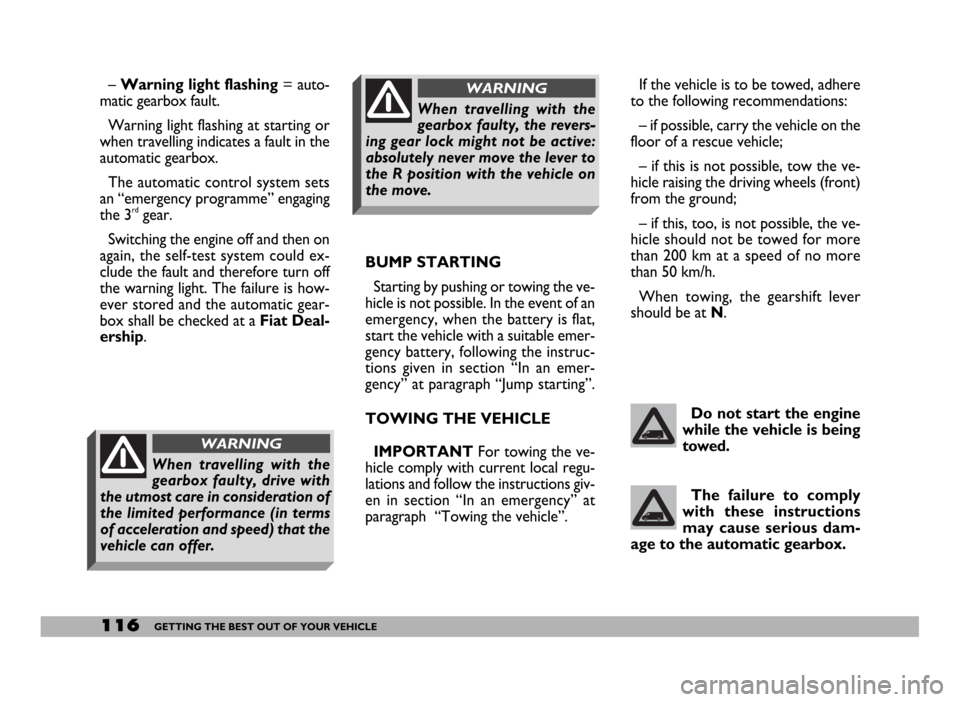
116GETTING THE BEST OUT OF YOUR VEHICLE
BUMP STARTING
Starting by pushing or towing the ve-
hicle is not possible. In the event of an
emergency, when the battery is flat,
start the vehicle with a suitable emer-
gency battery, following the instruc-
tions given in section “In an emer-
gency” at paragraph “Jump starting”.
TOWING THE VEHICLE
IMPORTANTFor towing the ve-
hicle comply with current local regu-
lations and follow the instructions giv-
en in section “In an emergency” at
paragraph “Towing the vehicle”.If the vehicle is to be towed, adhere
to the following recommendations:
– if possible, carry the vehicle on the
floor of a rescue vehicle;
– if this is not possible, tow the ve-
hicle raising the driving wheels (front)
from the ground;
– if this, too, is not possible, the ve-
hicle should not be towed for more
than 200 km at a speed of no more
than 50 km/h.
When towing, the gearshift lever
should be at N.
Do not start the engine
while the vehicle is being
towed.
The failure to comply
with these instructions
may cause serious dam-
age to the automatic gearbox.
When travelling with the
gearbox faulty, drive with
the utmost care in consideration of
the limited performance (in terms
of acceleration and speed) that the
vehicle can offer.
WARNING
When travelling with the
gearbox faulty, the revers-
ing gear lock might not be active:
absolutely never move the lever to
the R position with the vehicle on
the move.
WARNING– Warning light flashing= auto-
matic gearbox fault.
Warning light flashing at starting or
when travelling indicates a fault in the
automatic gearbox.
The automatic control system sets
an “emergency programme” engaging
the 3
rdgear.
Switching the engine off and then on
again, the self-test system could ex-
clude the fault and therefore turn off
the warning light. The failure is how-
ever stored and the automatic gear-
box shall be checked at a Fiat Deal-
ership.
Page 137 of 258
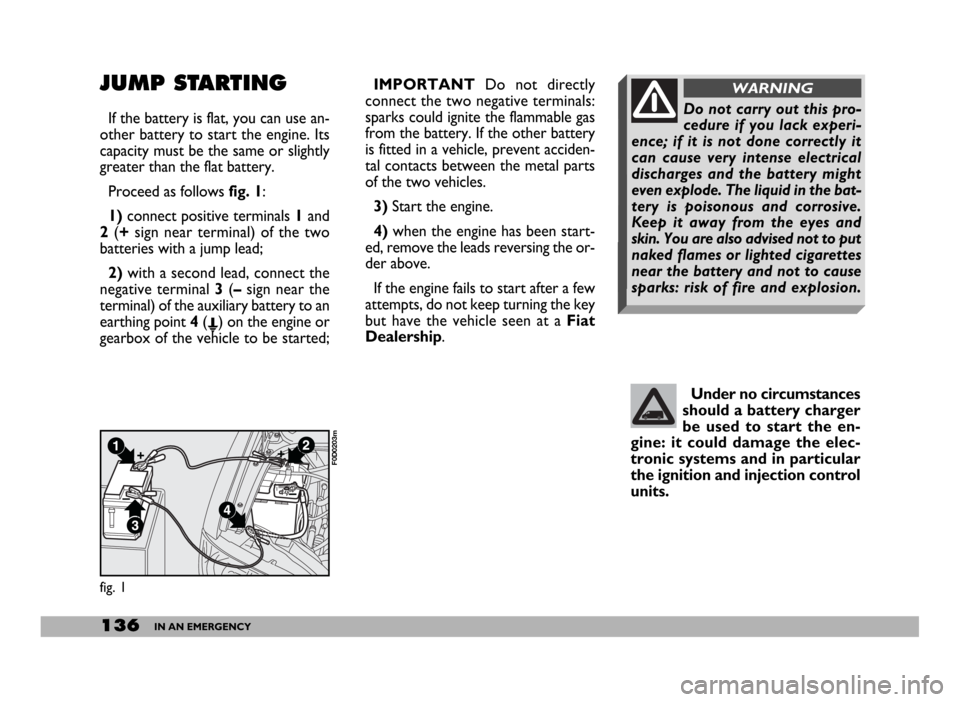
136IN AN EMERGENCY
JUMP STARTING
If the battery is flat, you can use an-
other battery to start the engine. Its
capacity must be the same or slightly
greater than the flat battery.
Proceed as follows fig. 1:
1) connect positive terminals1and
2 (+sign near terminal) of the two
batteries with a jump lead;
2) with a second lead, connect the
negative terminal 3(– sign near the
terminal) of the auxiliary battery to an
earthing point 4(E) on the engine or
gearbox of the vehicle to be started;IMPORTANTDo not directly
connect the two negative terminals:
sparks could ignite the flammable gas
from the battery. If the other battery
is fitted in a vehicle, prevent acciden-
tal contacts between the metal parts
of the two vehicles.
3) Start the engine.
4)when the engine has been start-
ed, remove the leads reversing the or-
der above.
If the engine fails to start after a few
attempts, do not keep turning the key
but have the vehicle seen at a Fiat
Dealership.
fig. 1
F0D0203m
Under no circumstances
should a battery charger
be used to start the en-
gine: it could damage the elec-
tronic systems and in particular
the ignition and injection control
units.
Do not carry out this pro-
cedure if you lack experi-
ence; if it is not done correctly it
can cause very intense electrical
discharges and the battery might
even explode. The liquid in the bat-
tery is poisonous and corrosive.
Keep it away from the eyes and
skin. You are also advised not to put
naked flames or lighted cigarettes
near the battery and not to cause
sparks: risk of fire and explosion.
WARNING
Page 138 of 258

137IN AN EMERGENCY
BUMP STARTING IF A TYRE IS
PUNCTURED
General instructions
Observe the instruc-
tions on this and the fol-
lowing pages to use the
jack and spare wheel correctly.Catalysed vehicles must
not be bump started
(pushed, towed or
coasted downhill) as this could
cause fuel to flow into the cat-
alytic exhaust system and dam-
age it beyond repair.
Never start the engine
when the vehicle is jacked
up.
WARNING
Remember that until the
engine has started the
brake booster and power steering
systems will not work and a greater
effort will therefore be required to
depress the brake pedal or turn the
steering wheel.
WARNING
If you are towing a trailer,
remove the trailer before
jacking up the vehicle.
WARNING
The jack should only be
used to changed a wheel on
the vehicle for which it was de-
signed. It should not be put to oth-
er uses or employed to raise other
models. Under no circumstances
should it be used when carrying out
repairs under the vehicle. An incor-
rectly positioned jack may cause
the vehicle to fall. Do not use the
jack to lift loads exceeding that in-
dicated on the label attached to the
to the jack itself.
WARNING
Page 158 of 258
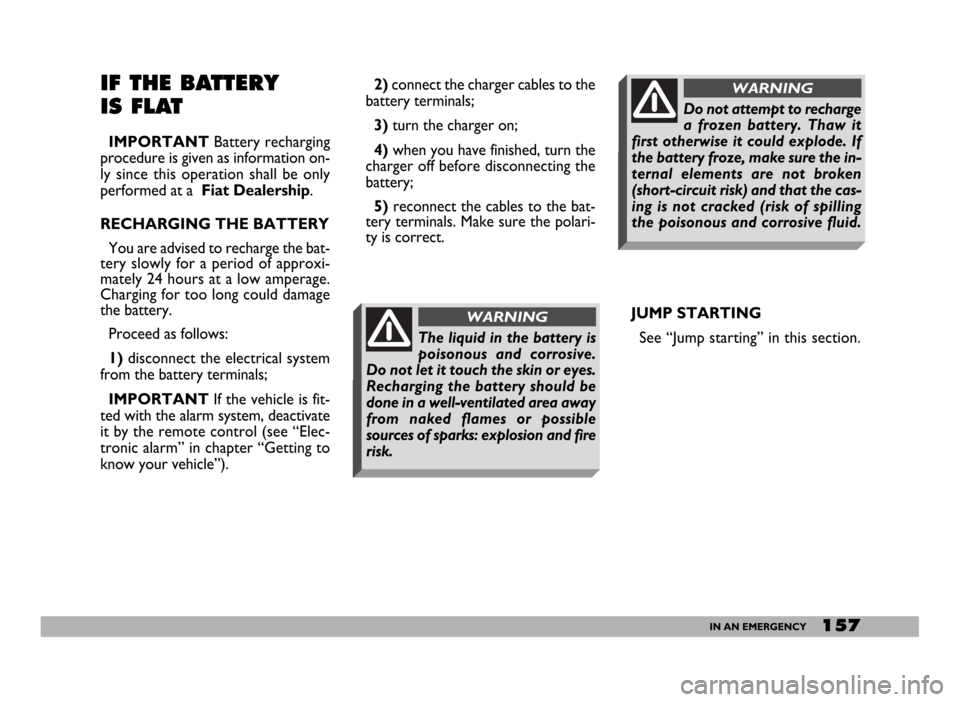
157IN AN EMERGENCY
IF THE BATTERY
IS FLAT
IMPORTANTBattery recharging
procedure is given as information on-
ly since this operation shall be only
performed at a Fiat Dealership.
RECHARGING THE BATTERY
You are advised to recharge the bat-
tery slowly for a period of approxi-
mately 24 hours at a low amperage.
Charging for too long could damage
the battery.
Proceed as follows:
1) disconnect the electrical system
from the battery terminals;
IMPORTANTIf the vehicle is fit-
ted with the alarm system, deactivate
it by the remote control (see “Elec-
tronic alarm” in chapter “Getting to
know your vehicle”).JUMP STARTING
See “Jump starting” in this section. 2)connect the charger cables to the
battery terminals;
3)turn the charger on;
4)when you have finished, turn the
charger off before disconnecting the
battery;
5) reconnect the cables to the bat-
tery terminals. Make sure the polari-
ty is correct.
The liquid in the battery is
poisonous and corrosive.
Do not let it touch the skin or eyes.
Recharging the battery should be
done in a well-ventilated area away
from naked flames or possible
sources of sparks: explosion and fire
risk.
WARNING
Do not attempt to recharge
a frozen battery. Thaw it
first otherwise it could explode. If
the battery froze, make sure the in-
ternal elements are not broken
(short-circuit risk) and that the cas-
ing is not cracked (risk of spilling
the poisonous and corrosive fluid.
WARNING
Page 160 of 258
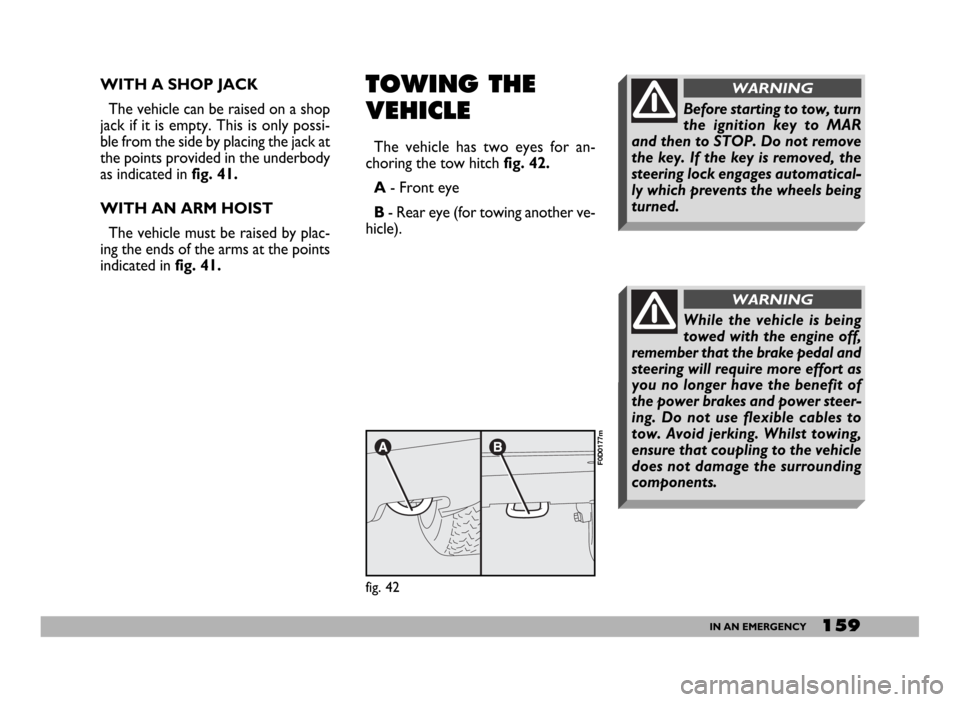
159IN AN EMERGENCY
WITH A SHOP JACK
The vehicle can be raised on a shop
jack if it is empty. This is only possi-
ble from the side by placing the jack at
the points provided in the underbody
as indicated infig. 41.
WITH AN ARM HOIST
The vehicle must be raised by plac-
ing the ends of the arms at the points
indicated in fig. 41.TOWING THE
VEHICLE
The vehicle has two eyes for an-
choring the tow hitch fig. 42.
A- Front eye
B- Rear eye (for towing another ve-
hicle).
fig. 42
F0D0177m
Before starting to tow, turn
the ignition key to MAR
and then to STOP. Do not remove
the key. If the key is removed, the
steering lock engages automatical-
ly which prevents the wheels being
turned.
WARNING
While the vehicle is being
towed with the engine off,
remember that the brake pedal and
steering will require more effort as
you no longer have the benefit of
the power brakes and power steer-
ing. Do not use flexible cables to
tow. Avoid jerking. Whilst towing,
ensure that coupling to the vehicle
does not damage the surrounding
components.
WARNING
Page 178 of 258
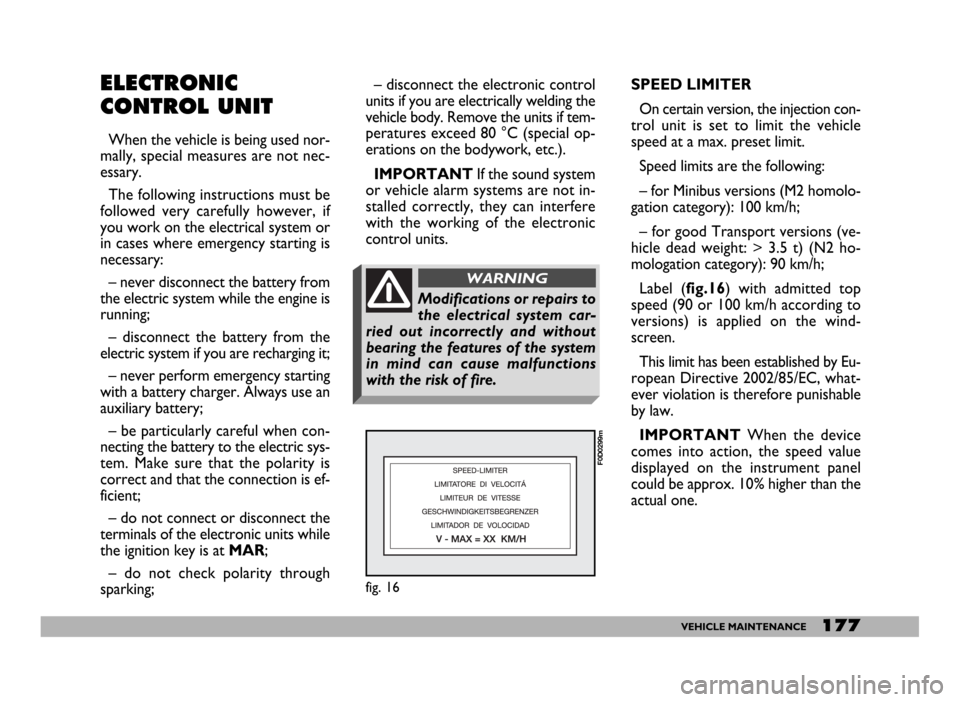
177VEHICLE MAINTENANCE
ELECTRONIC
CONTROL UNIT
When the vehicle is being used nor-
mally, special measures are not nec-
essary.
The following instructions must be
followed very carefully however, if
you work on the electrical system or
in cases where emergency starting is
necessary:
– never disconnect the battery from
the electric system while the engine is
running;
– disconnect the battery from the
electric system if you are recharging it;
– never perform emergency starting
with a battery charger. Always use an
auxiliary battery;
– be particularly careful when con-
necting the battery to the electric sys-
tem. Make sure that the polarity is
correct and that the connection is ef-
ficient;
– do not connect or disconnect the
terminals of the electronic units while
the ignition key is at MAR;
– do not check polarity through
sparking;– disconnect the electronic control
units if you are electrically welding the
vehicle body. Remove the units if tem-
peratures exceed 80 °C (special op-
erations on the bodywork, etc.).
IMPORTANTIf the sound system
or vehicle alarm systems are not in-
stalled correctly, they can interfere
with the working of the electronic
control units.
Modifications or repairs to
the electrical system car-
ried out incorrectly and without
bearing the features of the system
in mind can cause malfunctions
with the risk of fire.
WARNING
SPEED LIMITER
On certain version, the injection con-
trol unit is set to limit the vehicle
speed at a max. preset limit.
Speed limits are the following:
– for Minibus versions (M2 homolo-
gation category): 100 km/h;
– for good Transport versions (ve-
hicle dead weight: > 3.5 t) (N2 ho-
mologation category): 90 km/h;
Label (fig.16) with admitted top
speed (90 or 100 km/h according to
versions) is applied on the wind-
screen.
This limit has been established by Eu-
ropean Directive 2002/85/EC, what-
ever violation is therefore punishable
by law.
IMPORTANTWhen the device
comes into action, the speed value
displayed on the instrument panel
could be approx. 10% higher than the
actual one.
fig. 16
F0D0299m
Page 248 of 258
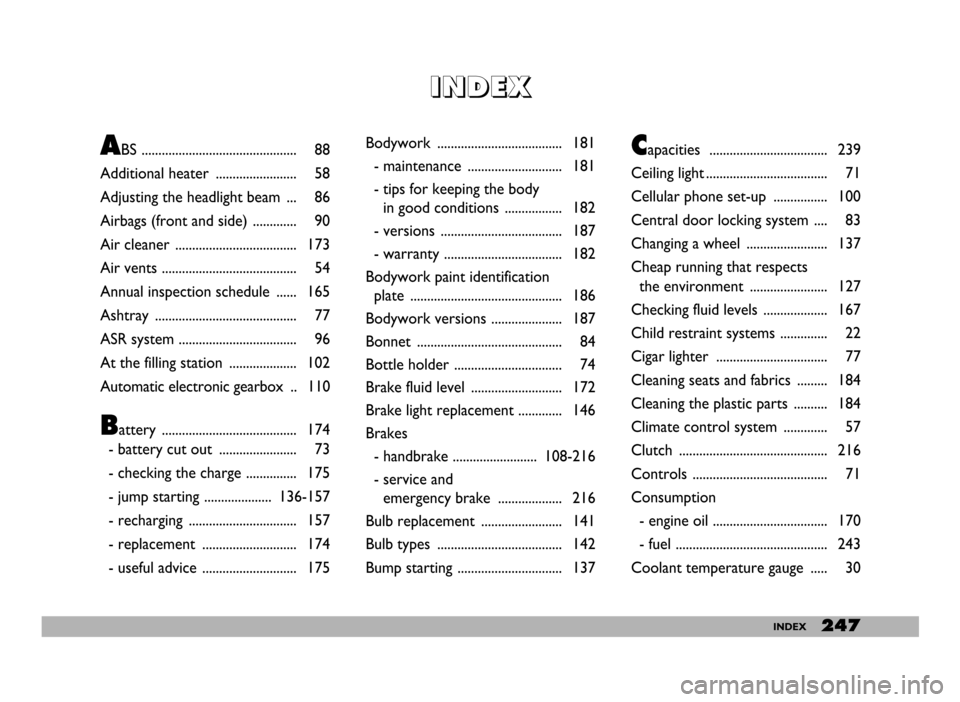
247INDEX
I I
N N
D D
E E
X X
Bodywork ..................................... 181
- maintenance ............................ 181
- tips for keeping the body
in good conditions ................. 182
- versions .................................... 187
- warranty ................................... 182
Bodywork paint identification
plate ............................................. 186
Bodywork versions ..................... 187
Bonnet ........................................... 84
Bottle holder ................................ 74
Brake fluid level ........................... 172
Brake light replacement ............. 146
Brakes
- handbrake ......................... 108-216
- service and
emergency brake ................... 216
Bulb replacement ........................ 141
Bulb types ..................................... 142
Bump starting ............................... 137Capacities ................................... 239
Ceiling light .................................... 71
Cellular phone set-up ................ 100
Central door locking system .... 83
Changing a wheel ........................ 137
Cheap running that respects
the environment ....................... 127
Checking fluid levels ................... 167
Child restraint systems .............. 22
Cigar lighter ................................. 77
Cleaning seats and fabrics ......... 184
Cleaning the plastic parts .......... 184
Climate control system ............. 57
Clutch ............................................ 216
Controls ........................................ 71
Consumption
- engine oil .................................. 170
- fuel ............................................. 243
Coolant temperature gauge ..... 30ABS .............................................. 88
Additional heater ........................ 58
Adjusting the headlight beam ... 86
Airbags (front and side) ............. 90
Air cleaner .................................... 173
Air vents ........................................ 54
Annual inspection schedule ...... 165
Ashtray .......................................... 77
ASR system ................................... 96
At the filling station .................... 102
Automatic electronic gearbox .. 110
Battery ........................................ 174
- battery cut out ....................... 73
- checking the charge ............... 175
- jump starting .................... 136-157
- recharging ................................ 157
- replacement ............................ 174
- useful advice ............................ 175